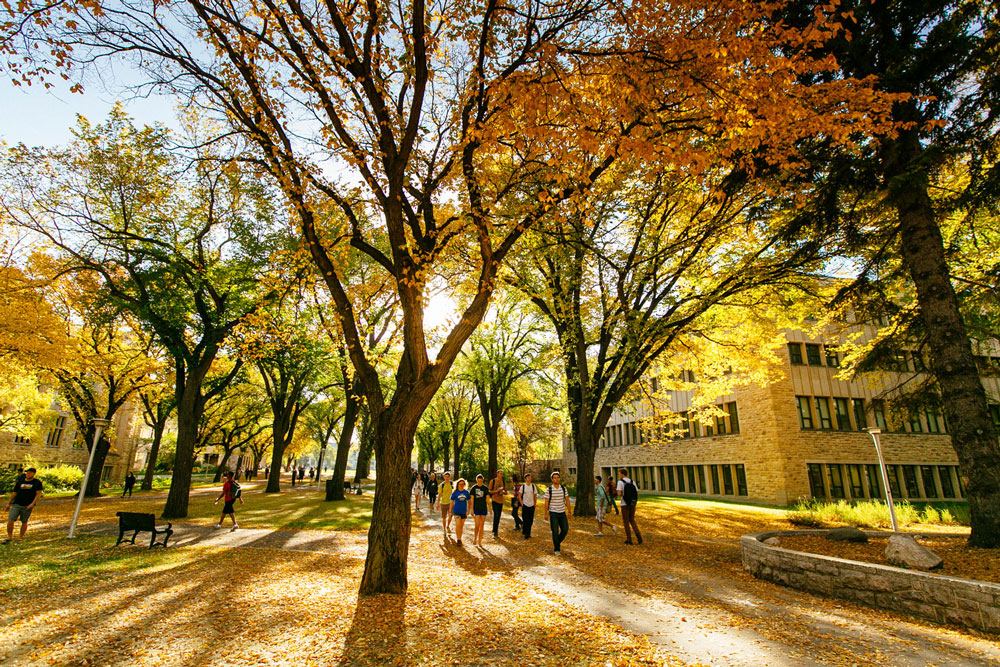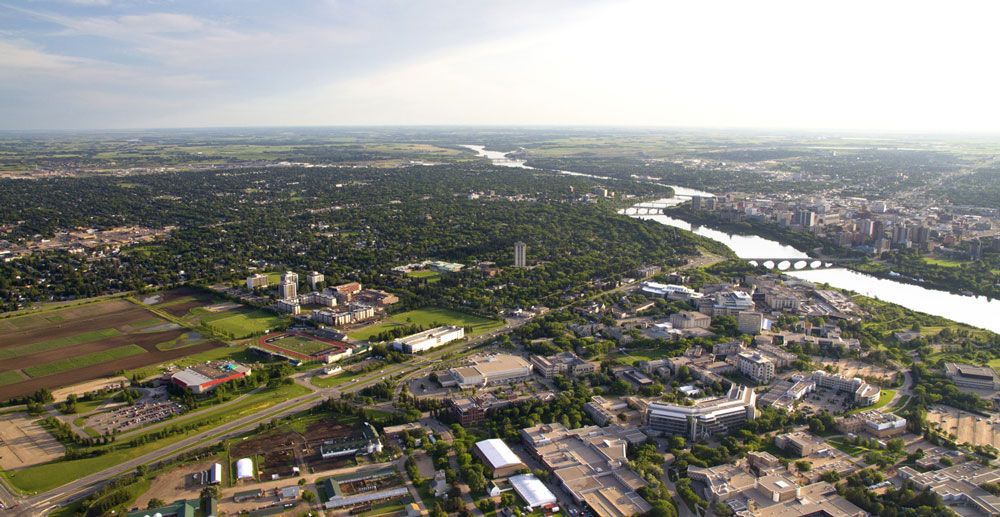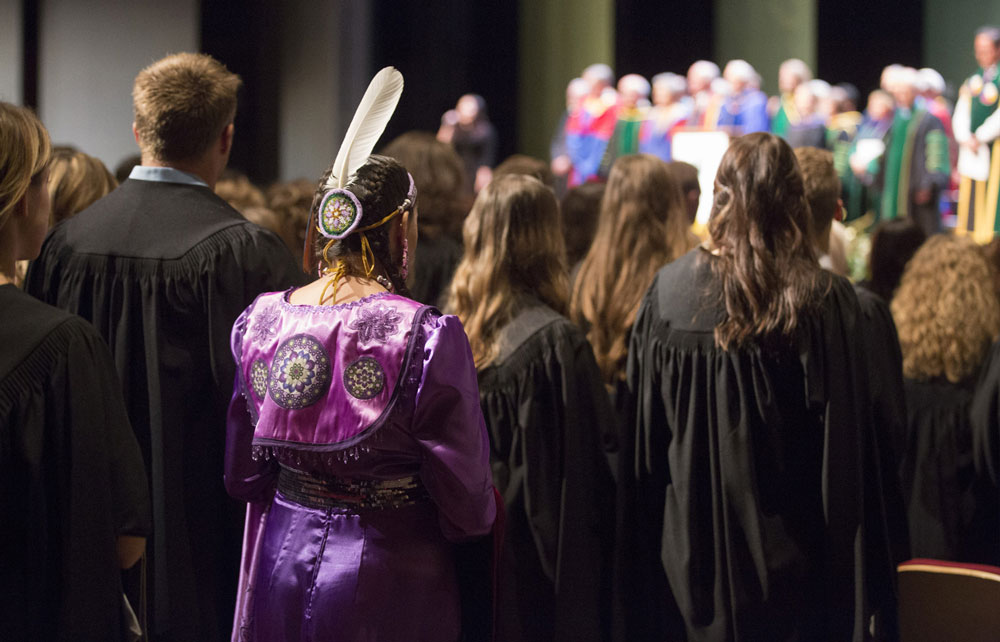General Academic Assembly 2017
Connectivity
By Peter StoicheffI want to acknowledge that we are on Treaty Six territory and the traditional homeland of the Métis. We pay our respects to the First Nations and Metis ancestors of this place and reaffirm our relationship with one another.
I’ve said on many occasions over the past year-and-a-half that universities are arguably more important now than they have ever been, and that the University of Saskatchewan is arguably more important now than it has ever been.
During that time, a lot has happened in the world. We’re now in the “post-truth” era: the independent arbitration of what’s true and what’s not true is less available to a public that needs it more. It’s not only a Trump-influenced phenomenon, though that’s the most recent and highest profile example. Journalists world-wide, scientists recently in this country and right now in the U.S., writers and scholars globally (at last year’s GAA I mentioned the Scholars at Risk program), continue to face challenges to their autonomy and influence, to their ability to connect with readers, viewers, politicians, thought-leaders and other audiences. Although technologically we live in a more connected world, culturally and politically we are at risk of living in a less connected one.

This leaves universities, and the U of S, with a commensurately larger role. Kim Campbell wrote in a February Globe and Mail op-ed that independently corroborated “truth” is the cornerstone of two institutions. One is journalism, where multiple verifiable sources are required for a fact to be stated. The other is academia, where peer review in all fields and reproducible experimental results in scientific ones determine what is considered true.
Henry Kissinger once famously quipped that university politics were so vicious because the stakes were so small. I never agreed with the statement, but it gets a lot of circulation. It’s evidently not true now. Now the stakes are so high that we cannot let recent budget reductions shift us from our Mission and Vision of building “a sustainable future.” Of “promoting diversity and meaningful change.” Of serving “the public good by connecting discovery, teaching, and outreach.” Of “advancing the aspirations of the people of this province and beyond.” Of living the values of “academic freedom,” “different ways of knowing, learning, and being,” “openness, transparency, and accountability,” “integrity, honesty, and ethical behaviour.” Of “inclusiveness.” Of “reconciliation.” And of “collaboration and connectivity.” I’ve said that the recent provincial budget will not define us. In this post-truth time—a most unusual one in the lives of all of us here in this hall—we need to ensure that is the case.
When these features of our Vision, Mission and Values document emerged last year, I read them as public commitments to ourselves. I now read them as much more than that—as commitments to what’s important everywhere in a time when they are deliberately challenged within, of all places, democracies themselves. What other type of institution in this country could have arrived at the same prescient statements except a university? And what other institution did arrive at these very ones except ours? Universities are needed now more than they have ever been. And the University of Saskatchewan is needed now more than it has ever been. These days I’m dropping the word “arguably."
I concluded last year’s GAA speech by saying that “in future GAA talks, I would like to build on how the university can imagine its future through the lenses of connectivity, diversity and sustainability. Moving the U of S thoughtfully into the future will involve all of us using whatever assignments we have to expand the possibilities for connectivity, diversity and sustainability.”
This year, I want to make good on that by concentrating on the first of those: Connectivity. There have been many temptations to concentrate on the other ones for this particular occasion. On “sustainability” for obvious reasons; on “diversity” for equally obvious ones. Adding a fourth—“creativity”—has now created the prism through which our next integrated plan will be projected. But the disconnections of the post-truth era led me to see that “connectivity” was the one for this GAA.
Simultaneously with my introducing these themes last April, “connectivity” was emerging as a dominant one in the Vision-Mission-Values early drafts. It reverberated through the thousands of consultations that produced the document. “We have a well-deserved reputation for ... collaboration” and for a “spirit of discovery, teaching and outreach.” We advance the aspirations of the people of the province and beyond through “efforts to share knowledge.” We “connect” discovery, teaching and outreach and “prepare students for enriching careers and fulfilling lives as engaged global citizens.” We “connect the needs and aspirations of our region with the world’s." Connectivity with our many communities pulses emphatically throughout our document. If we are at risk of living in a disconnected world, replete with immigration orders, Brexit, journalists’ muzzlings, post-truths, intolerance, walls between friendly countries, political ignorance and defiance of democratic law, the Vision document we endorsed last fall tells us that the openness and engagement explicit in connectivity is worth talking about today.

There are many ways in which, as a university in this country, we are connected. Two years ago Universities Canada engaged Bruce Anderson, formerly of Decima research and now Abacus, a member of CBC’s “At Issue” panel and a Globe & Mail columnist, to poll Canadians on their attitudes toward universities. His findings are encouraging for all of us involved in university work, and reveal that universities are well connected to the public imagination. “The value perception of universities is strong,” he stated to a Universities Canada meeting in Ottawa in the fall of 2015 and again to our Senior Leadership Forum last summer. In Canada 77% of those polled had a positive response to universities; 20% had a neutral one; 2% held a negative opinion. This contrasts with the United States, where a positive view is held by only 47% of the population. In this country, support for universities is equal across provinces, age groups, income brackets, political affiliations. Overall, the takeaway is that Canada is not a society that questions the fundamental value of universities—quite the opposite. There is a belief that our economy will only remain strong if people receive a university education. “Be confident,” Anderson told us, and “tell our stories.”
Anderson’s findings parallel what I reported in last year’s GAA speech. At about the same time he was conducting his poll, 90% of people surveyed in Saskatchewan believed we offer students a high-quality education; 95% believed we are important to Canada; and 89% believed our teaching and research are beneficial to the community. Those are significant numbers that reflect a very high level of support and connection. In our case, the numbers are gratifying but not all that surprising, given that we are one of Saskatchewan’s largest employers with over 6,200 people working here full-time or part-time, and given that our per capita impact on the provincial economy ranks first or second among all 97 Canadian universities. I have come to work here each day for over thirty years sensing that support, and feeling pretty good about contributing in some way to it—and I hope you all can feel that way as well, because you are contributing to it, and the work you’re doing in that regard is evident far beyond the campus. We are recognized as serving “the public good by connecting discovery, teaching, and outreach” and as “advancing the aspirations of the people of this province and beyond” as our Vision document claims.
Anderson summed up his findings by saying: “trust that people share our values;" “be confident, not defensive;” “understand that universities are regarded as good for students, good for society, and good for the economy;” and “share our stories and powerful statistics.” What are some of the stories that we have shared this past year?
- U of S awarded $77.8M (by the Canada First Research Excellence program) to lead Global Water Futures research program: this made us the only university in the country to receive two CFREFs;
- VIDO-InterVac received $700K for developing a better animal model that researchers say will help them not only understand the Zika virus better, but test new vaccines and drugs;
- A new $8.4 million Saskatchewan MS research chair was announced at U of S: Rates of MS, a debilitating disease of the central nervous system, are the highest in the world in Saskatchewan and Canada. To lead the research program focused on identifying causes of MS and developing new or improved treatments, the U of S has recruited a renowned MS researcher from the U.S.;
- The Saskatchewan Centre for Cyclotron Sciences started supplying Royal University Hospital with radioisotopes in June of 2016. Prior to that, the hospital received radioisotopes from Hamilton, Ontario. More Saskatchewan patients will now be able to receive PET-CT scans with a supply that comes from the University of Saskatchewan campus rather than from across the country – meaning an earlier start to clinic hours and fewer missed patient appointments due to transport delays or cancellations;
- An interdisciplinary team of U of S faculty and students has been investigating the declining health of Saskatchewan River Delta
- A University of Saskatchewan PhD student is conducting brain research that could help make brain surgery safer and more effective. This new approach is already helping Saskatoon surgeons plan brain surgeries;
- Saskatoon, led by the U of S, will host the 2018 International One Health Congress, an event that is expected to bring more than 1,000 researchers and health professionals from around the world to share their work and create new research collaborations;
- We held our second Reconciliation Forum – our first internal one – to measure how far we’ve come in addressing the TRC’s Calls to Action and discuss how to continue to improve in this area;
- The U of S and the Library received an historic donation of Inuit Art that will be one of the most extensive in the country, and contains archival material for new research as well.
- PotashCorp Kamskénow program continues to link U of S math and science students with community schools;
- Bill Waiser, professor emeritus in History, received this year’s Governor-General’s Award for Non-Fiction for his book A World We Have Lost: Saskatchewan Before 1905;
- Our Law college has partnered with the Government of Nunavut to deliver a law degree program;
- We signed an MoU with the FSIN;
- U of S was profiled in The Atlantic recently for our commitment to Indigenous engagement and Indigenous student success;
- The U of S is about to be profiled for our Indigenous work in the New York Times;
- We signed a first-in-Canada agreement between a university and a symphony orchestra;
- We have designed and created a Board of Trustees for our Huskie Athletics organization;
- We received an upgrade to our National Sustainability Ranking, from Silver to Gold, making us one of only a handful of universities in Canada to have that designation;
- The U of S and the USSU signed a partnership agreement on campus sustainability initiatives;
- Three unique-in-Canada research centres at the University of Saskatchewan were awarded almost $69 million in federal infrastructure funding through the Canada Foundation for Innovation’s Major Science Initiatives program, enabling them to stay at the forefront of international science in protecting human and animal health, developing new medical imaging techniques and providing critical radar mapping of electromagnetic “space weather” just above Earth’s atmosphere;
- U of S Education professor Jay Wilson received the country’s most prestigious post-secondary teaching honour, the 3M National Teaching Fellowship; and
- For those of you who attended last spring’s Women of Distinction Awards event, you will know that U of S leaders cleaned up there, with the majority of awards going to our faculty, staff and students. And I see in today’s paper that many more of our faculty, staff and students are nominated in various categories for this year’s awards.
These are accomplishments—connections—of which we can be justly proud.

“Nevertheless,” Bruce Anderson said about his poll findings, “63% of respondents believed universities need to change.” The poll’s findings did not detail what people believe those changes should be. Recent events in the U.S. and the U.K., however, suggest a growing suspicion—at times rejection—of institutions, particularly institutions regarded as “elite” such as traditional media, political parties’ machinery and leadership, and at times universities. The media and political parties have been taken by surprise in Canada and far beyond it because they seemed stuck in the past. Although we’re not seeing it at the moment, we need to guard against the possibility of the same for universities. We can’t relax about support from the broader community. We all share the responsibility of communicating what we do, and its value. Although we tend to know much of what goes on at universities in all its complexity, the public doesn’t, and can often be puzzled or bemused by what they read about us.
The fundamental errors committed by institutions in any sector that lead to suspicion of them, rejection of them, or a weakening of support for them are these: they don’t communicate well; they don’t see the need for change and so they don’t plan for it, or plan at all; they interpret their past successes as proof of inevitable future successes; they become out of touch with what people actually need of them and how to respond to those needs. Anderson’s results show that we are needed; we must ensure that, as those needs change, we respond to them. We’re at a unique time in the history of post-secondary institutions. We cannot become out of touch.
What are those realities, and how do we need to change? Yogi Berra retorted once that “it’s hard to make predictions, particularly about the future.” So instead of making those predictions myself, let me turn to those who are in the business of making predictions that many do listen to.
On February 6th of this year, Canada’s Advisory Council on Economic Growth released its five short reports containing “bold ideas that will significantly improve Canada’s economic growth trajectory.” As much as anything else does, these reports identify the changes that lie ahead for Canada and countries like it. I attended an early morning meeting with the reports’ author Domenic Barton and half a dozen university presidents in Ottawa that day, after which he spoke at Universities Canada’s “Converge” conference, attended by university presidents and over a hundred students including three from the U of S. February 6th was a hurricane day of official presentations and media coverage for Barton. The fact that he chose to start it off with university presidents, followed by a Universities Canada presentation involving students, signalled the importance he places on the post-secondary role in responding to and leading the changes his report foresees.
“Canada faces significant economic headwinds,” his first report begins, “including a rapidly aging population and a stubbornly low level of productivity. In the years ahead, unprecedented technological change presents a large set of opportunities but also the potential for significant workforce dislocation.” He went on to state at the conference that “40% of today’s jobs will be automated in the next ten years.” That fact in itself, which caught students’ attention, will require new social contracts because skilled workers will be sidelined, and will also require new educational strategies for preparing today’s students for that eventuality. In response, one of his recommendations is “to prepare workers for major structural changes on the horizon, such as the automation of jobs and the growth of the ‘gig’ economy” (in which temporary jobs are commonplace and companies tend toward hiring independent contractors and freelancers instead of full-time employees: by 2020, 40% of the Canadian employed population is predicted to be temporary workers).
Our students are still getting jobs and moving into careers at a high rate. Our statistics tell us that, plus I hear anecdotally that employers give U of S graduates top priority. But how can we ensure we remain this successful in the future? And how can we ensure we are preparing students for “unprecedented technological change and significant workforce dislocation”?
One way is to recognize that a university like ours—research intensive, medical-doctoral, with a unique scientific infrastructure—must seek opportunities for participating in the country’s innovation agenda. There is no university in Canada that has the array of colleges and schools we do, and none with the infrastructure we have. Canada lacks the networks of U.S. labs, state and private, that contribute to innovation (eg. national centres for disease control and prevention, Microsoft, Apple, Corning). In Canada, universities are mostly it. And of those 97 universities in Canada, the U15 members like us are really it. The U of S has the variety of programming and research, and the faculty and staff and student talent, to develop the best culture of innovation in the country, and to benefit our students looking for careers as a result.
The communities we serve: this city, this province, Canada, and countries beyond it need medical isotopes, new vaccines, answers to global water and food challenges, answers to MS and Zika and diabetes. They need us to capitalize on our strength in agrifoods (repeatedly identified in Barton’s report). They need our philosophers to engage with the enormous ethical issues raised by modern medicine and by IT. They need social scientists to be indispensable parts of the process of digital disruption. They need solutions to carbon emissions, greenhouse gasses, clean energy goals and other critical sustainability challenges. They need answers to urban design and transit issues, population growth and immigration shifts. They need everyone to work on reconciliation. They need artistic performance and the humanities to provide critical commentary on all of this.
We need to be listening for these needs, recognizing we must play a significant role in addressing them, maintaining a flexibility in programming and research to do so, and developing ways to engage the many communities we serve that will increasingly depend on us as we move into an era of “unprecedented technological change.”

That is one piece of the connectivity challenge for us. It requires connecting our student and faculty talent with digital disruption and design thinking. It requires recognizing the power of start-ups and emerging tech companies. A significant percentage of the top 100 start-ups in Silicon Valley are led by Canadians, many of whom are, as it happens, from the humanities. Start-ups are not only ends in themselves that can create marketable products. They’re far more: a way of “developing a mindset for engaging with the world” (University Affairs, March 2017). University of Toronto’s Creative Destruction Labs is a thriving example (Globe and Mail cover story, Saturday, March 18, 2017). Connectivity requires a full-court press on work-integrated learning, internships, and co-ops (not just passing fads) at the undergraduate and graduate levels; bridging internationally in research, student recruitment and study abroad opportunities; and engaging our students and researchers with our alumni. It requires positioning graduate degrees to lead to many opportunities other than the academic workplace, and supporting students to develop “cross-functional ability, communication skills and learning agility” (the ability to move outside one’s area of expertise).
It requires supporting and listening to our new faculty and to our students. In the past ten years we have renewed 60% of our faculty complement. We renew a high percentage of our students every year. New faculty, and our students, are interdisciplinary-minded, community-engaged, impatient with institutional barriers, looking for ways to connect with the world and with each other, and start-up oriented. They’re creatures of connectivity. If we do not support and listen to our new faculty and our students, we will lose potential faculty talent to the profit sector before they ever come to the university, and we will fail in our stated mission to “prepare students for enriching careers ... as engaged global citizens.”
What else can we do to move forward on “connectivity”? Capitalize on two things: the fact that we are one of the most multidisciplinary universities in the country with 17 colleges and schools, and the fact that, as our Vision document states, we use “interdisciplinary and collaborative approaches to discovery.”
Interdisciplinarity is not a goal in itself. It is a means to an end to meet the global challenges I listed earlier. The world’s greatest challenges won’t be met by a single researcher in a single discipline but by many researchers in many disciplines combining forces. There are many reasons why we were the only university in the country to be successful in both CFREF competitions. One is that we already have interdisciplinary strength here. Global water security, as an example, involves every one of our six Signature Areas of Research: Aboriginal Peoples; Agriculture; Energy and Mineral Resources; One Health; Synchrotron Sciences; and of course Water Security. Each Signature Area of Research is interdisciplinary. The premise of each of our graduate schools is that it is interdisciplinary. The concept behind “the health sciences” is that it is interdisciplinary. “Toxicology” is interdisciplinary. The Wilson Centre for Entrepeneurship and Innovation, Arts and Science, Nursing’s Clinical Skills Labs, the design of the Health Sciences Building, of the Collaborative Science Building—all these are interdisciplinary. The Interdisciplinary Centre for Culture and Creativity is, well, interdisciplinary. A School of Architecture will be interdisciplinary. Agriculture and Bioresources is interdisciplinary. So is SWITCH, the Student Wellness Initiative Toward Community Health. Medicine and Computer Science are collaborating to improve medical imaging. Indigenous ways of knowing are interdisciplinary.

We need to make the most of this campus-wide tendency by being purposeful about establishing interdisciplinary and inquiry-based programming and research among our academic units. We need to build it into our students’ earliest university experiences. It involves critical thinking but it also demands horizontal thinking, applying what you learn in one discipline to what you need in another. We need to build on our various successes in this area so that it becomes explicit, not just implicit, in our culture, and by constantly imagining ways of restructuring ourselves through connectivity, not along predictable disciplinary lines, to drive this.
The next integrated plan is a timely opportunity for us to do this on a university-wide scale. To create an interdisciplinary culture internally, and to respond to the external challenges people believe we are here to meet. In sum, to practise throughout the university the connectivity that drives our Vision and that will be one of the cornerstones of the integrated plan, alongside sustainability, diversity and creativity.

